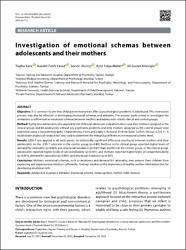| dc.contributor.author | Kara, Tuğba | |
| dc.contributor.author | Yavuz, Kaasım Fatih | |
| dc.contributor.author | Ulusoy, Sevinç | |
| dc.contributor.author | Maner, Ayşe Fulya | |
| dc.contributor.author | Kılıçoğlu, Ali Güven | |
| dc.date.accessioned | 2023-04-14T08:53:41Z | |
| dc.date.available | 2023-04-14T08:53:41Z | |
| dc.date.issued | 2023 | en_US |
| dc.identifier.citation | Kara, T., Yavuz, K. F., Ulusoy, S., Maner, A. F. ve Kılıçoğlu, A. G. (2023). Investigation of emotional schemas between adolescents and their mothers. Düşünen Adam - Journal of Psychiatry and Neurological Sciences, 36(1), 4-12. https://dx.doi.org/10.14744/DAJPNS.2022.00201 | en_US |
| dc.identifier.issn | 1018-8681 | |
| dc.identifier.issn | 1309-5749 | |
| dc.identifier.uri | https://dx.doi.org/10.14744/DAJPNS.2022.00201 | |
| dc.identifier.uri | https://hdl.handle.net/20.500.12511/10866 | |
| dc.description.abstract | Objective: It is common to see that child-parent interaction affects psychological problems in adulthood. This interaction process may also be effective in developing emotional schemas and attitudes. The present study aimed to investigate the similarities or differences in emotional schemas between mothers and adolescents in both clinical and control groups.Method: Eighty-two adolescents who applied to the child and adolescent outpatient clinics and their mothers (assigned as the clinical group) and 80 adolescents without any psychiatric problems and their mothers (assigned as the control group) were examined using a Sociodemographic Characteristics Form and Leahy Emotional Schema Scale Turkish Version (LESS-T). A multivariate analysis of variance test was used to determine the intergroup differences in emotional schema levels.Results: LESS-T was applied to all participants. No statistically significant difference was found between mothers and their adolescents on the LESS-T subscales in the control group (p=0.89). Mothers in the clinical group reported higher levels of demand for rationality (p=0.003) and emotional avoidance (p=0.01) than mothers in the control group. In the clinical group, adolescents reported higher levels of uncontrollability (p=0.007), and mothers reported higher levels of comprehensibility (p=0.001), demand for rationality (p=0.001), and emotional avoidance (p=0.007).Conclusion: Mothers' emotional schemas, such as avoidance and demand for rationality, may prevent their children from expressing and experiencing emotions sufficiently. Findings emphasize the importance of healthy mother-child interaction for developing emotional skills. | en_US |
| dc.language.iso | eng | en_US |
| dc.publisher | Kare Publishing | en_US |
| dc.rights | info:eu-repo/semantics/openAccess | en_US |
| dc.subject | Adolescent | en_US |
| dc.subject | Avoidance Behavior | en_US |
| dc.subject | Emotional Schema | en_US |
| dc.subject | Metacognition | en_US |
| dc.subject | Mother-Child Relations | en_US |
| dc.title | Investigation of emotional schemas between adolescents and their mothers | en_US |
| dc.type | article | en_US |
| dc.relation.ispartof | Düşünen Adam - Journal of Psychiatry and Neurological Sciences | en_US |
| dc.department | İstanbul Medipol Üniversitesi, İnsan ve Toplum Bilimleri Fakültesi, Psikoloji Bölümü | en_US |
| dc.authorid | 0000-0003-3862-2705 | en_US |
| dc.identifier.volume | 36 | en_US |
| dc.identifier.issue | 1 | en_US |
| dc.identifier.startpage | 4 | en_US |
| dc.identifier.endpage | 12 | en_US |
| dc.relation.publicationcategory | Makale - Uluslararası Hakemli Dergi - Kurum Öğretim Elemanı | en_US |
| dc.identifier.doi | 10.14744/DAJPNS.2022.00201 | en_US |
| dc.institutionauthor | Yavuz, Kaasım Fatih | |
| dc.identifier.wos | 000951849300002 | en_US |
| dc.identifier.scopus | 2-s2.0-85156208325 | en_US |
| dc.identifier.scopusquality | Q3 | en_US |


















